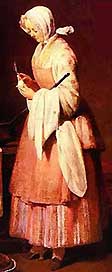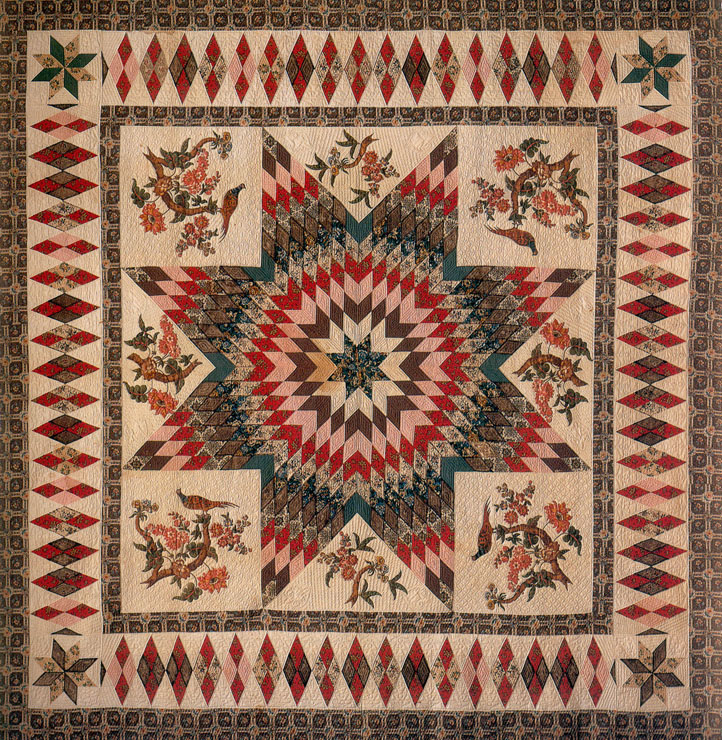 |
Colonial Woman
![]()
During the 18th century, womenís work was extremely difficult, exhausting, and under appreciated. Most colonial women were homemakers who cooked meals, made clothing, and doctored their family as well as cleaned, made household goods to use and sell, took care of their animals, maintained a cook fire and tended the kitchen gardens. Middle class and wealthy women also shared some of these chores in their households, but they often had servants to help them.
Both men and women had great social pressure on them to marry. Young girls were often married by the age of 13 or 14. Women who were not married by the age of 25 were socially humiliated. Women married mostly for social and economic reasons, not for romantic ones. Once married, a woman became the legal property or chattel of her husband. Married women had no control of their earnings, inheritance, property, and also could not appear in court as a witness or vote. Husbands could legally beat their wives. If a woman ran away from her husband, she was considered a thief because she was stealing the clothes she was wearing and herself. If a man murdered his wife, he would be hung. If a woman murdered her husband, she would be burned alive.
Widows were better off. They had control over their property, but could only receive up to one-third of her late husbandís property. A widow could also vote in some areas, but often widows were not aware of this fact or chose not to vote. In addition, widows were pressured to get married as soon as possible. In some colonies, laws were proposed that forced widows to marry within 7 years after their husbandís death. Widows, however, were often married within a year if not sooner.
Given the difficult life that most colonial women faced, it should not be surprising that many frontier women, when captured in Indian raids chose not to return to their communities and spent the rest of their lives as adopted members of the tribe by whom they were captured. Follow this link for the story of one such captive.
Women's Work
Colonial housewives and cooks began their days very early by modern standards. They built the fire, carried water, gathered fresh fruits and vegetables for the day's meals from the kitchen garden, got meat from the smokehouse, and prepared breakfast. This meal usually consisted of mush with milk, which was sweetened with molasses. The mid-day meal, dinner, was the heaviest, generally served between noon and 3 pm. This meal was commonly a stew, the ingredients of which varied with the seasons. The advantage of serving stew was that it required little tending from the housewife and required only one pot. Puddings could also be steamed in fabric bags suspended above the cooking pot of stew. Individual portions of meat and vegetables were uncommon in the colonies until the 1700's, and then were had by well-to-do colonists. Supper, the evening meal, was generally warmed up leftovers.
Women trained girls to be wives and mothers by having them help around the house. Girls helped with cooking, preserving food, caring for children, cleaning the house, washing clothes and gardening. They milked cows, churned butter, and made cheese. Girls' work was important to cloth making. After the men and boys grew flax and sheared sheep, girls and single women did the spinning, knitting, sewing, and sometimes weaving. Girls spun wool and flax so that it could be woven into fabric or knitted into socks, hats, scarves, and mittens. They usually brought yarn to weavers to have cloth woven and they used the cloth to make clothing and sacks. Girls sewed by hand, with strong, tiny stitches that would hold clothes together during many washings over years of wear. Most girls became wives and mothers who worked on the farm and in the house. Some became midwives, servants, tavernkeepers, or school mistresses. Girls could not go to college.
Every Colonial housewife made a supply of candles in autumn. Candle rods, each with a row of wicks, were made by repeatedly dipping in big iron kettles of boiling water and melted tallow. This was an all-day, back-breaking job. Better candles were made by pouring the tallow into pewter molds, which made produced 6 to 24 candles. Store bought cotton twist, flax fibers, or the silky down from milkweed pods were used as wicks.
 |
 |
 |
 |
 |
 |
 |
Entertainment
The Quilting Bee was an imporant means of socializing for colonial and pioneer women (and men). Through the winter months, the women would piece their quilt tops. Since there was no central heating in these homes, there was usually only one main heated room that was too crowded during the winter months for a quilt frame to be assembled. When the weather became warmer, an invitation was sent to the surrounding neighbors for the quilting bee. On the day of the quilting bee, the quilters would arrive early and begin marking the quilt top which had been put into the quilt frame by the hostess. Very often, plates, thimbles, and tea cups were used to mark the quilting patterns. The quilters would then being to quilt the top while exchanging conversation. The quilt had to be finished before the husbands showed up in the late afternoon when dinner was served to all. The hostess was given a chance to show off her cooking skills. After dinner, there was very often a square dance or country dance with fiddles accompanying the dancers. The quilting bee was an important part of the social life of these people and was surpassed only by religious gatherings.
You can learn a tremendous amount about the daily life of a woman from our period of study by following this link and reading Martha Ballard's Diary.
Learning Aids | Great Law of Peace | US Constitution | Timeline | Works Cited
© 1 October 2001, Portland State University